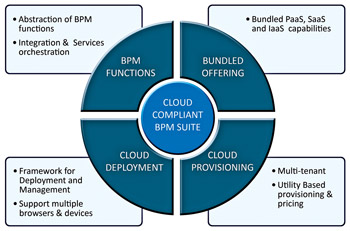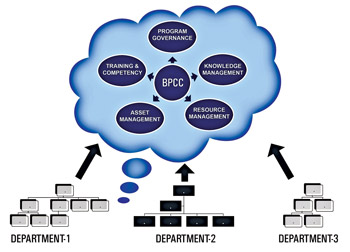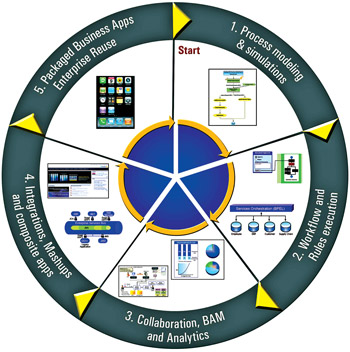The emerging confluence of BPM and Cloud Computing
Vinaykumar Mummigatti Vice President and BPM
Practice Leader
Every few years we come across a new wave in technology which either
reshapes the direction of the technology landscape or enhances
substantially the application of existing technologies.
Cloud computing is one such wave which seems to be setting a new
trend in the technology world. Cloud computing, with roots in ‘Grid
computing’, involves provisioning of dynamically scalable and
virtualized resources over the internet as a service.
|

Fig 1: Basic elements of cloud compliant BPM suite |
|

Fig 2: Business Process Competency Centre (BPCC) on cloud |
This could be offered as Infrastructure or Platform or Software as a
service. The realization of significant business value around cloud
computing has suddenly created a hype and we see a spurt of activities
with technology and business stakeholders planning to adopt the
platform.
For lack of accepted standards, proven scale, performance and many
unknowns surrounding the cloud based environment, I would still refer to
this as an emerging trend.
But this concept has deep rooted value and benefits, that address
many challenges surrounding local server based hosting and deployment of
enterprise applications.
BPM (Business Process Management) is one such technology space which
is embraced by most enterprises but facing significant challenges in
terms of hosting and implementation.
Let us explore how cloud computing can compliment BPM in addressing
enterprise adoption challenges.
BPM is a relatively well known term and has become a major
transformation tool leveraged by businesses to model, automate and
optimize their processes.
BPM is still going through a hype cycle as many organizations have
tried their hands at BPM and seen limited to medium success.
Less than 25 percent of organizations implementing BPM have reached a
high level of maturity and success.
Gartner analysts have predicted that more than 50 percent of BPM
Programs will fail by 2011.
Based on a prediction by Gartner Analyst Michele Cantara, “The share
of BPM investments targeting end-to-end business processes that
incorporate external services or cloud resources will increase 500
percent by 2012”.
Definition of a cloud compliant BPM suite
A cloud-based implementation would derive value from three areas:
Economic (No capital investments, Pay by use, expand/shrink resources as
needed), Architectural (commonly accessible environment and resources
for development and self-service provisioning), Strategic (outsourced
ownership of infrastructure and operations enabling focus on core
activities).
A BPM suite must address these value elements for being classified as
cloud compliant. The below diagram summarizes the capabilities and
design elements that address this compliance.
A comprehensive ability to offer the following services is a must for
BPM suites:
a. PaaS: Platform as a service capabilities such as Multi tenancy
services - metering and billing, authentication, user management and
asset management, application engines - Data, Process, Rules, Content,
BAM, UI, Portal etc.
b. SaaS: Software as a Service - packaged applications, on-demand
provisioning and pricing by use
c. IaaS: Infrastructure as a Service - Cloud infrastructure and
management (Operating system, Failover, backup and disaster recovery and
virtualization capabilities) is key to evaluate any BPM suite for cloud.
Addressing key challenges in BPM adoption
BPM offers a very compelling set of business transformation
capabilities and demonstrable Return on Investment (ROI). But why do
more than 50 percent projects still fail to meet the expectations and
desired adoption level? Some of the inherent challenges and issues and
how BPM on cloud can help in solving these problems are listed below:
Technology constraints: No single BPM tool that can meet all the
requirements for an enterprise. BPM technology decisions made in one
business context cannot be applied to all problem areas. Technology
itself can be a major inhibitor to successful adoption of BPM.
|

Fig 3: Five step approach to introducing BPM on cloud |
Cloud benefit: Access to BPM on cloud makes a big difference in
trying out different technologies with no big bang investments. Ease of
provisioning and utility based pricing is a great boon when business
needs to be convinced of any technology.
Time to market: When the time taken to provision the hardware and
software with all other operational elements is more than a few months,
the time to market and the agility offered by BPM loses its meaning and
eventual loss of faith from business users.
Cloud benefit: BPM on cloud brings down the infrastructure readiness
time from a few months to minutes or days.
This is a dramatic change in the way Business will embrace BPM
without the hurdles thrown by IT and Infrastructure.
Collaboration across and within enterprises: BPM enables an
enterprise to collaborate in terms of intra and inter organizational
processes.
Localized BPM implementations do not support external supply chain
and value chain processes.
Departmental BPM implementations on local environments defeat the
larger objective of orchestrating end-to-end business processes which
reflect in the strategic KPI’s and operational excellence.
Cloud benefit: BPM on cloud offers borderless environment when
geographically dispersed teams need to be supported for complex
processes.
Cloud based BPM facilitates collaboration with partners across supply
chains in managing processes that cut across environments.
Business Process Competency Center (BPCC) and Enterprise Rollout: As
organizations start rolling out BPM at enterprise level, the focus
shifts to Governance, Standardization, Optimization and Scalability for
successful adoption and realization of BPM benefits. Most organizations
are structured as silos and their BPM investments are departmental.
The need for standards, open architecture, reusable components with
interoperability and knowledge management emerge as strategic needs.
In a traditional organization there is no motivation for anyone to
have a shared infrastructure and assets that can be leveraged across
teams.
Cloud benefit: Cloud environment provides a centralized and commonly
accessible BPM medium for achieving enterprise level process excellence.
The ability to collaborate and share will be easily facilitated due
to the very nature of shared infrastructure and commonly accessible
environment.
Hosting a Business process competency center on cloud will provide an
institutionalized medium to enable above functions.
BPCC on cloud will help organizations take a leap forward in
achieving success from their BPM initiatives and also establish
governance, collaboration and reuse of assets.
BPM on cloud: Five-step approach for effective introduction
If there are so many benefits around BPM on cloud, then why are
enterprises still sitting on the fence to adopt? Is this due to lack of
knowledge on how to approach BPM on cloud or the uncertainty and fear of
the unknown? Or is it because of the unproven ROI? Definitely there is a
better support needed in terms of the decision tree around when to
implement an application on cloud versus local hardware.
These questions could span security, performance, governance, shared
usage, time to market, user access control and the product capabilities
to run in a cloud environment.
What is the role of IT versus business in this decision? There is a
need for step-by-step approach which will help the incremental exposure
to hosting BPM on cloud and realizing the benefits. A progressive
approach described below will be helpful for effective introduction of
BPM on cloud within an enterprise and ensure better success.
To be continued |



